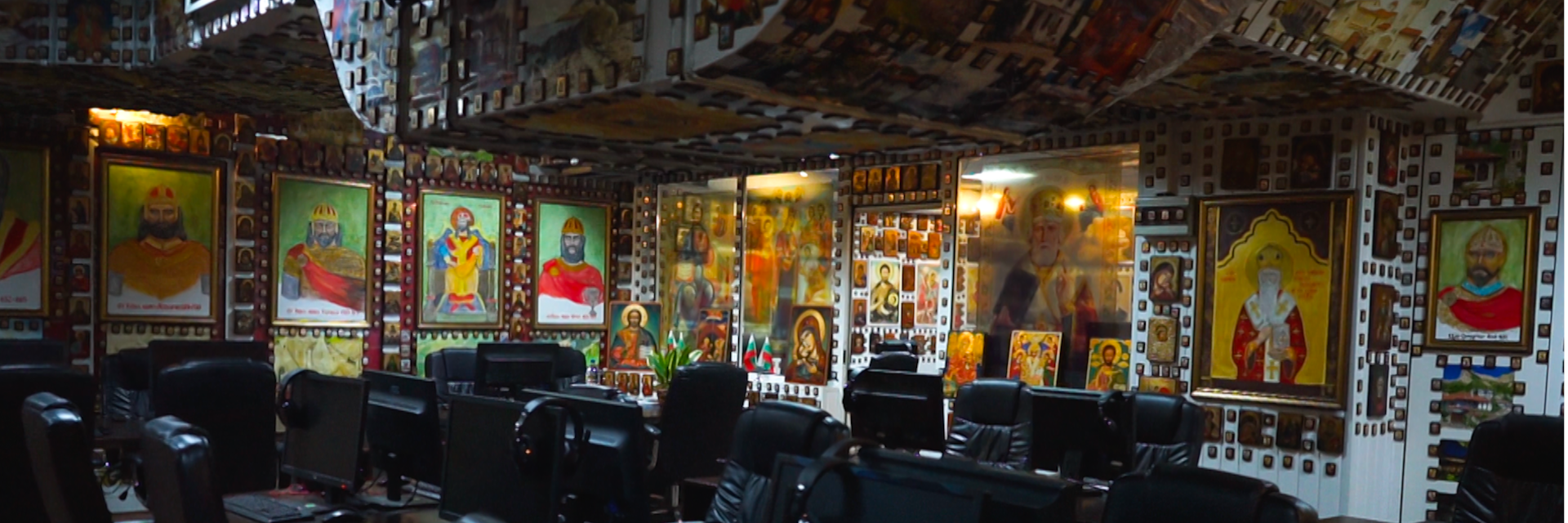
20-02-24
Gods and robots – a conversation with Natalia Jordanova
“Religion can be considered a form of primordial virtuality that humans have been practising for years."
An internet cafe covered in religious iconography; a ruined, obsolescent church ; the Church Slavonic roots of the word 'robot' – these and other peculiar resonances between technology and religion abound in Natalia Jordanova's visual essay Visits to Other Possible Worlds (2022). With the work screening at LI-MA Presents: New Art on Screen on 6 March, the artist speaks to Manique Hendricks about its conception and the questions it raises about (trans)humanism, our belief systems and technological futures.
Author Manique Hendricks
What was the starting point for Visits to Other Possible Worlds?
Everything started with a news article I came across one day, telling the story of a man called Rosen Hristov, who produced the first humanoid robot in Bulgaria. An engineer in his 30s from the city of Shumen, he made it all by himself in his garage. He later wins the country's only fair for youth technical inventions in a town called Gorna Oryahovitca. To me, the story was as exciting as it was surreal because it portrayed someone's reality. Against the backdrop of highly technological labs worldwide, with big teams and enormous budgets dedicated to developing humanoid and other types of robotics as an extension of humans' prospects in the world and their ability to relate to it, there was this man who made something innovative in isolation in a small garage and from recycled parts. I stayed with this story and tried to figure out within my process what was in it that I found so stimulating. The idea of a human who realises his dream to create another human seemed to me like a present-day Mary Shelley plot. That's also where the absurdist aspect comes into play. I was asking myself about the state of today's society to produce such a narrative as someone's reality.
Another critical aspect of the visual essay was its specificity. The worlds I create in my work and the speculative relations I build within them draw their meaning from a context. Still, simultaneously, they are rarely bound to a distinct locality. Hence, this case study felt like a challenging entry point and personal in a different way. Through the story, I made a space to work on it as a research direction and try to understand a more comprehensive picture of Bulgaria's past technological development. One of the texts that influenced me a lot, thinking about what I wanted to bring across, which I didn't know then, was Victor Petrov's essay “Communist Robot Dreams”, published in Aeon in 2020. In fact, it is a snippet of his more extensive work: a PhD dissertation for Columbia University in 2017 called A Cyber-Socialism at Home and Abroad: Bulgarian Modernisation, Computers, and the World, 1967-1989, where he weaves a compelling narrative in support of his point through stories of relation, for how Bulgaria became a leader in tech and sci-fi. Another read was a New York Times article from 1985 with the headline “Bulgaria’s Ambitious High-Tech Goals”. The latter's premise flows naturally in the third text I want to mention: Ralitsa Gerasimova's essay “Fiction during Communism or the Future that Did not Come” (translated).
Initially, I intended to create a film about him. As much as it was based on reality, I was interested in more than just the directness of the purely documentary approach. I also wanted to access a fictional space. The anticlimactic moment came when, after months of softly formulating the idea and putting together the puzzle, we had a call, and he turned me down. It was tough, but I took that as part of the process and continued from there. The story grew already, and I was too much into it. Besides, it was also impossible to just erase him. I owed him the mention, since his invention was the initial instigation. Here is how he becomes at the outset of the film, and there was no other way but to start my narrative with him.
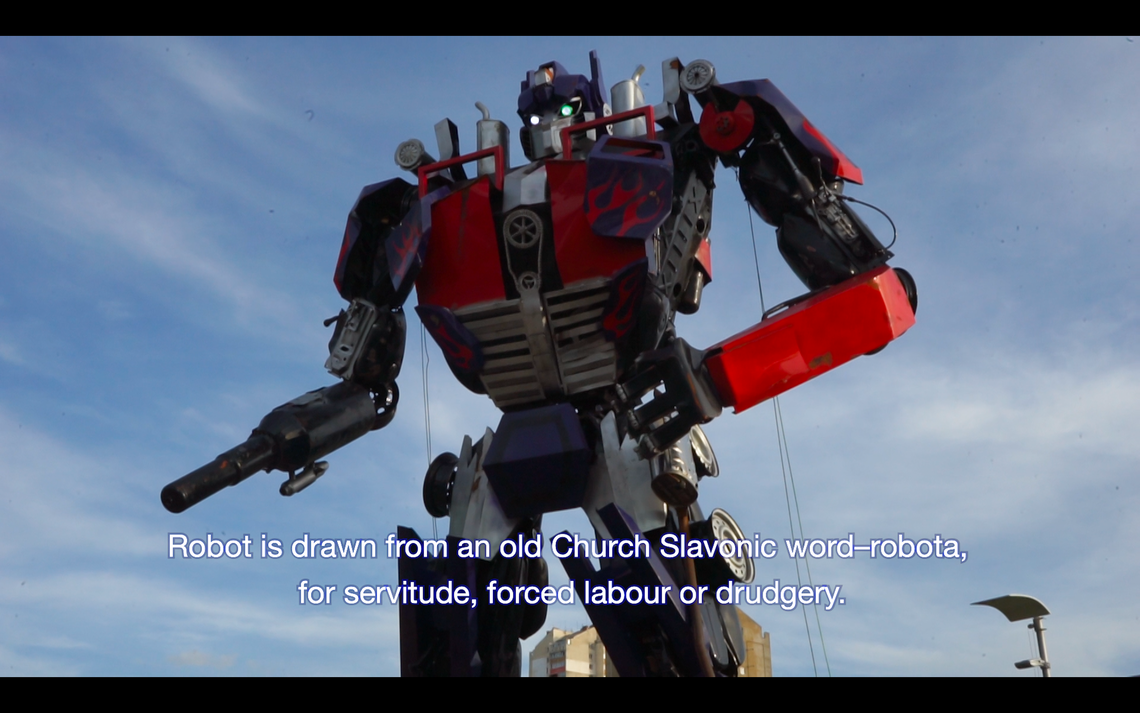
The work is divided into four different parts. Can you tell more about that?
The parts in the film signify the four distinct realities, and all the scenes are shot within them. The first two are localities – places somewhere – and the last two are someone's realities. They are other to each other, and the separation puts them in their own category, like a made-up taxonomy relevant to the script. Through the graphics and the gamified interface, I wanted to propose them as possible portals to be accessed. The connections come from the voiceover and the argument, which is slowly building, putting them in perspective and suggesting a bigger narrative.
I created this structure to function as containers to identify the common matrix between these worlds. The POV shot or the subjective camera not only implies what the subject would see, captured as if seen through the eyes of a character, but it also reflects how I was exploring those spaces myself. They are visualised with the visit and experienced through the contemplations of the first-person narrator. From the church to the internet cafe, the robotic park and finally, the sculptor who created a robot, they move from more grounded and clear-sighted to more carnivalesque and poetic – both in the potential of the locations and the voice of the narrator.
I still think this work turned out somehow strange. The way the story builds its main pillars is akin to how I usually think about developing a work. It reveals the line of thought in making connections between things, existing and sometimes invisible, using them to build a speculative idea that becomes central to the piece. And within that process of complexity and a rather maximalist approach, I intend to give space for sense-making and emotional experience.
Where does your interest in religion, technology, humans and the relationships between them come from?
My interest in any specific topic and the connections that can be revealed come initially from curiosity and the urge to understand how we humans are in the world. And to do that, I often need to look beyond the human. This is a somewhat unattainable goal if you are not being reductive. Still, these approaches and other angles of looking at things are what I find engrossing to explore and play with. If we go further, it is my position from which I experience what's around me.
This work aims to reflect and make analogies with the values of the system of beliefs. Putting those realms in perspective gives some space to think pro-complexity versus binary oppositions. Over-simplifying and going for what's on the surface is usually strongly stereotypical. I ask myself how we reached the point where digital technology became such a fundamental part of how we relate to the world, what conditions facilitated that, and how they impact our emotions. This is similar to how religion was a predominant system for a long time, one of the reasons being that scientific knowledge lacked the answers it can provide today. And by saying that, I'm not taking the side of science, if any. My voice in the film is more of the process of thinking out loud.
And here I have a peculiar story about myself being the only religious person in my family until age ten. Within the Orthodox Christianity backdrop, that meant I could assert my faith as I was defining it and roll with it. I was baptised at eleven: more or less the time I stopped identifying as religious.
The analogy between religion and technology as a system of beliefs is not noble, and I'm not interested in debunking it either. Let's remember that the average internet user uses it because it is there. After all, it is available, and this is not questioned. Artists, designers, thinkers, theorists, philosophers, and others who critically analyse technology and its impact on us as humans, our relationships, and the potential future – we are a minority in the larger context, a drop in the sea.
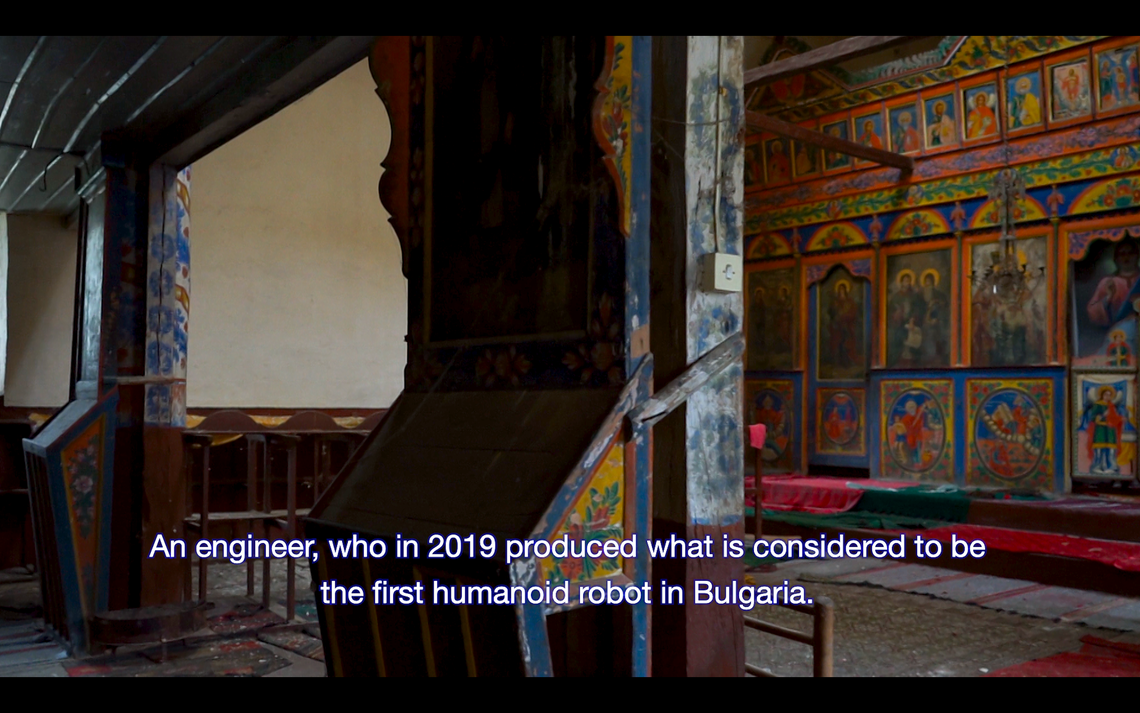
How did you stumble upon the abandoned church in the village of Malak Izvor?
With my partner back then, we celebrated their birthday in the tiny village, at a guest house called "The House of the Herbs". While we were strolling around, fantasising about the houses we peeked at, we noticed the church, which drew our attention with its slightly atypical wooden exterior. As we got closer, we realised it was abandoned, with a lock on the door. This was unusual because my previous impressions were that no matter how few inhabitants a residential place had, the church was always intact.
One of the glasses on the door was broken, so we could partly see the interior filled with bright-coloured icons. A desolate and neglected church gives you chills, as one can still feel it's charged with energy. Since we couldn't get in, we walked away. However, the next day I had a strong urge to find a way to enter and film inside. I started checking the web to see if it was a myth that you could open a lock with safety pins. Apparently, it was not, and we went back armed with some thin wire.
The attempt to open it that way was amusingly unsuccessful, but because of the broken window, I fit my hand inside and took an image of how the lock was attached. Then I realised that if I could reach it with my phone, I could also unwind the bolt. And so, we were safely inside without any violent actions or breaking in. We didn't touch anything, only looked at the surroundings through the camera. The unstaged walk of a first-person perspective is what you see in the film.
What do old belief systems tell us about our relationship with technology nowadays?
I think that technology, in all its variations – from prehistoric and primitive to advanced, invisible, seamless, fully integrated and highly complex – represents a form of belief that evolved in parallel with the developments of the time. In a way, I compare them when pointing out the desires and needs that led to their establishment. By making this parallel, they just tell us something about the present we live in, suggesting that humans have not changed fundamentally. Only the artefacts through which they manifest their aspirations and needs for progress have evolved. Similar to the evolution of the human species, both religion and computer technology haven't followed a linear path of development, and their ideas have not remained static. Therefore, they are much more intertwined and integrated than we might initially assume.
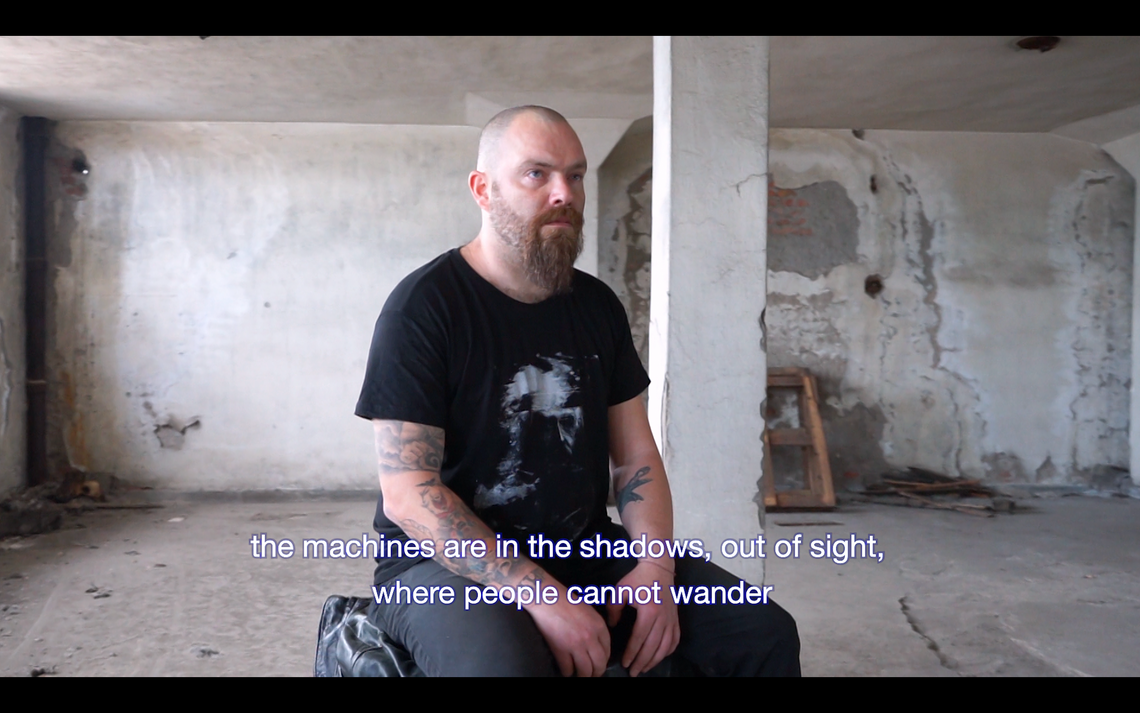
What is the relation between Greek myths and robots? Why and how did you incorporate this in your work?
It is a widely shared understanding and a popular conception that humanoid robots are primarily associated with advanced technology, the future, and science fiction societies. However, that's far from the truth.
As my narrative in the visual essay goes, “Gods and Robots have been present in myths, machines, and ancient dreams of technology. After all, thousands of years before machine learning and self-driving cars became a reality, the tales of the giant bronze robot Talos, the artificial woman Pandora, and their creator god, Hephaestus, filled people's imaginations in ancient Greece.”
A few years ago, my primary focus was on the impact of those accumulated ideas in the present. In 2020, while working on my MA thesis, I decided to explore historical narratives to understand how concepts related to technology and what we now perceive as futuristic developed in the past. This resulted in my text “SOFT, HARD, WET – Speculative Genealogy of the Artificial.” In it, I consider mythology, literary fiction, and the production of robotic and synthetic bodies as part of a non-linear record building toward what I define as genealogy. It moves between stories, imaginations, and speculations on the relationship between humans and their silicon cousins, the real creatures living inside the computer, and in humans' collective and personal desires.
Is the internet cafe covered in icon imagery a real existing place? Do people still make use of it?
Yeah, it's pretty incredible that such a place exists, right? I was already aware of it when I discovered the church and was making the montage between the two on my mind. I felt there was a potential for them to build on each other in the larger narrative. That's why I was eager to enter the church, regardless of restricted access. Neither the church nor the internet cafe were functioning in their intended ways. One was abandoned, and the other lost its necessity due to the development of network technology. Funnily enough, the cafe served as a private hangout venue for people who, at the time, were attempting to enter politics with a religion-oriented party.
What are the similarities between religion and the internet you want to emphasise in your work?
The question I asked myself and presented in the film is whether religion and the internet are so other. Each represents a predominant system that aligns with the state of knowledge and fulfils society's needs at the time. Still, they only seem to belong to something distant. I begin to support this proposition when I hint at the human's innate need to connect to something bigger, to a network where every participant understands the protocol, a commonality that applies both to religion and the internet.
The flow of reciprocity between fact and fiction in religion and the internet, as factual and imaginary space, is decided upon by the people engaging with them. Similarly, I leave the conclusions and potential associations to the viewers. I aim to enable them to actively discern what is authentic and explore the differences between the two when viewed as larger structures born out of necessity to fit the current condition.
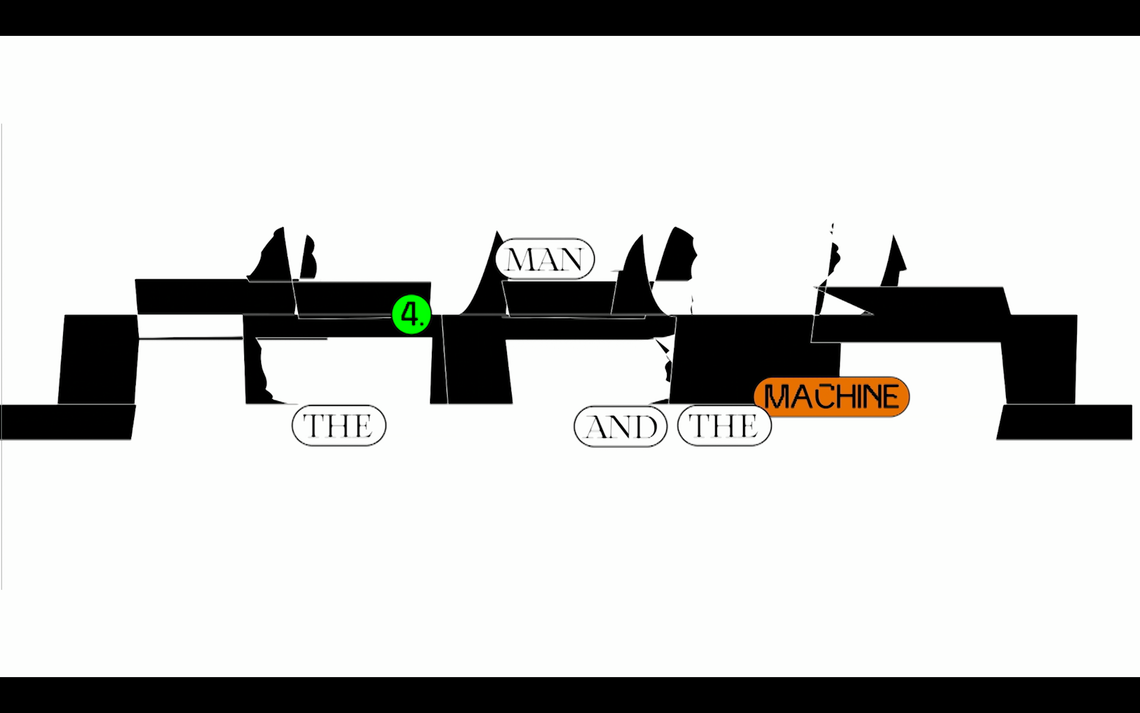
Discover more about Ali Eslami on his own website
How does transhumanism translate to both religious and online practices?
If we think of the primary premisses of transhumanism, we can easily use them with equal success in discussions about religious or networked spaces. Similar to the concept of Heaven in religion, virtual reality (VR) promotes a utopian, progressive movement where no laws of physics and nature bind us. This brings me back to the Genealogy of the Artificial thesis, where I discuss the artificiality of human-made, technologically induced processes. There, I note that mutation and natural selection are both natural processes through which the diversity of species unfolds. For transhumanists, the goal is to remove biological limitations with the help of enhancements, a deliberate redesigning of the human body using technology they call direct or participant evolution. The question is, Who plays the role of natural selection in that artificially created process when natural evolution mutations, though harmful, are balanced by it? When we think of the impacts we cause on nature, an analogy to mutation is needed to describe the fast-paced catastrophic potential of non-natural human activity.
The same assurances of safety, omnipotent fantasies, and the promise of immortality in a different reality are often the same factors driving people to religion. Drawing on those relations, I propose in the film that religion can be considered a form of primordial virtuality humans have been practising for years.
How can a story about robots make us rethink what it’s like to be human?
In any case, the response to that question will be quite philosophical. Let's specifically focus on the definitions of humans as sentient beings, a concept rooted in Buddhist thought. Every reflection about how we exist in the world, relate to it and perceive the external environment offers insights into our nature. As a creation of humans, robots are saying much about our never-ending quest for progress, advancements and the need for power by surpassing our limitations. It is moving to me that we can feel empathy for a non-human robot or other entity that might be harmed. This suggests that sentience can be viewed in a non-anthropocentric manner, where moral considerations are granted to natural objects such as animals, plants and landscapes. If this idea extends beyond specialised theoretical circles and becomes widespread, we may have to reassess what it means to be human or how we connect with the external world.
How do you see the future of religion in online spaces? Will there be more VR ceremonies in the future, for instance?
This part of the research and its role in the story was among the most unexpected for me. I was struck by the fact that even religion adapts to technological developments and moves its rituals online. The COVID-19 lockdown also brought extraordinary changes, with mediation substituting believers' physicality. But this appears only like a transition of the media, from sacred text to new media, resulting in the phenomenon of online churches.
My surprise perhaps comes from the eerie gap between what I know or feel about religion and how the online systems function. It is whimsical to think that a service needs to choose its app for communication technology, which I find somehow anachronistic and radical. Will there be more VR ceremonies in the future? Perhaps, yes. I think the development of Neo-Pagan rituals will rise. It is just a system and protocol to be learned until it becomes part of the collective idea of what's accepted and normalised, and not many will question it. Whether I want to experience a significant event in my life and share it with others in VR is a hard no. I'll go offline. But it is fascinating.
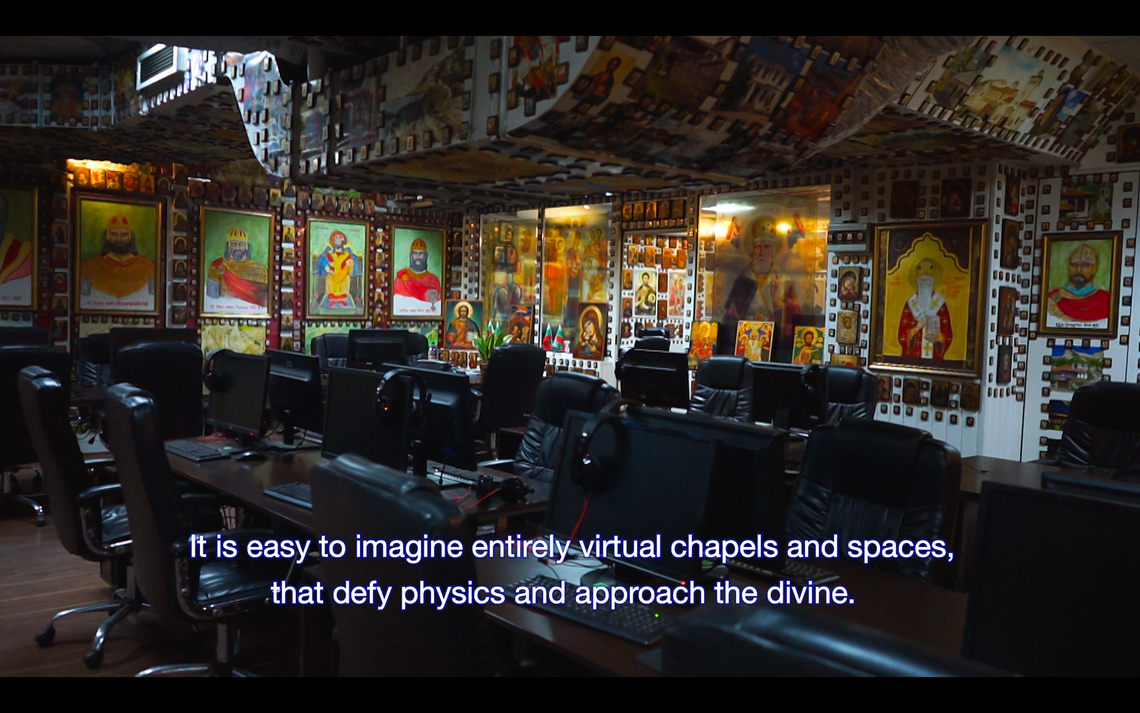
Natalia Jordanova is an interdisciplinary visual artist born in 1991 in Sofia, Bulgaria, working between Amsterdam and Sofia.
As part of an ever-developing quest for possible worlds and the extensive use of speculation, Natalia's artistic practice is a projection of the future, a subjective synthesis and a material proposition of what defines the present moment. Through her approach and by deploying various practices, she builds context-aware installations. They translate materialities and study the sculptural possibilities in the exchangeability of the flat and three-dimensional. Her work engages with the shift between digital and physical and weaves together narratives of past accumulations and future speculations.
Her education includes an MA at the Dirty Art department of Sandberg Institute in The Netherlands (2020), a BA in Fine Arts from the Royal Academy of Art in The Hague (2018), a BA in Photography from the National Academy of Theatre and Film Arts in Bulgaria (2013) and Erasmus exchange programme at Central Saint Martins in London (2017).
Her most recent presentations include a solo exhibition At Cu29 Gallery, Plovdiv, Bulgaria; participation in Something Else Cairo Biennale at the Citadel in Cairo, Egypt; a residency and an exhibition at the Goethe-Institut Cairo (2023); a group exhibition "Needles in a Haystack" at Bulgaria's National Art Gallery (2023); a solo show "Deep Daydream Reality: The Opening Scene" at Sofia City Art Gallery (2023); visual art residency at iMAL, Brussels, organised by BOZAR and Goethe-Institut, Belgium, in the context of the Halaqat project (2022); group exhibition Market of desire: earthly/heavenly, Sofia; screening–premiere at Goethe-Institut as part of Sofia Art Week in September 2021; duo show at POST, Arnhem; solo exhibition at Rosa Stern, Munich and a Virtual Reality residency "Authentic Spaces" in Zeitz, Germany. In 2020, she participated in the Unfair Temporary Museum in Amsterdam, a group exhibition at the Sofia City Art Gallery for the BAZA Award for contemporary art, a solo presentation at Art Rotterdam 2020, where she received a nomination for the NN Art Award. Her work has been exhibited internationally in The Netherlands, Bulgaria, Belgium, Germany, Egypt and the UK.
Manique Hendricks is a Dutch-Peranakan Chinese art historian. From 2018 to 2022 she worked for LI-MA as communication officer, junior curator (at the time the interview with Natalia Jordanova was conducted) and as a curator. Manique currently works as the curator of contemporary art at Frans Hals Museum and as a guest curator at the Amsterdam City Archives. As a freelance curator, writer and researcher she specialises in contemporary (media) art, visual and digital culture. In her practice Manique touches upon themes as identity, representation, the body, camp and club culture. Her writings have been published by Stedelijk Studies, NXS Magazine, Mister Motley, The Institute of Network Cultures, Tubelight and The Hmm.
*This interview was conducted in 2022 but edited in early 2024 for publishing.

